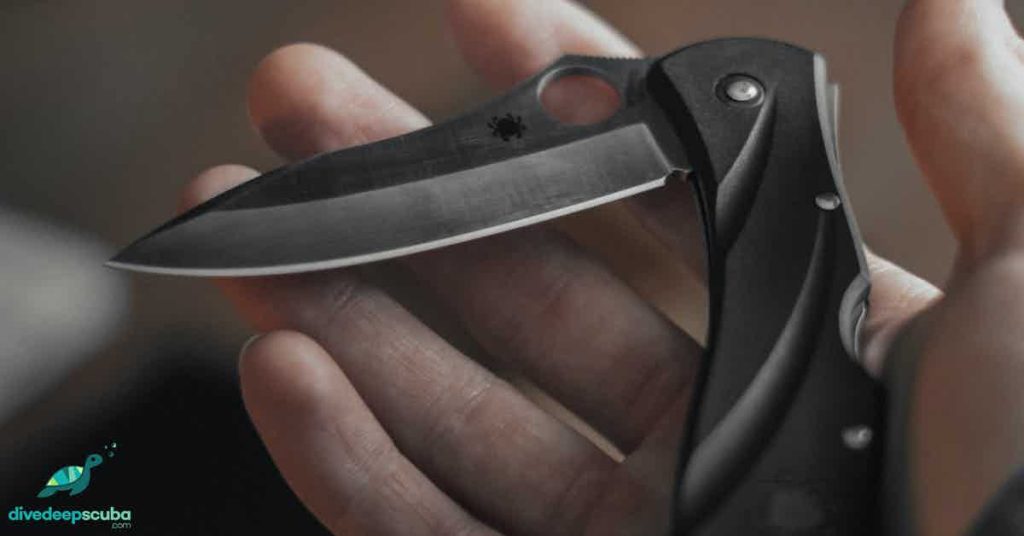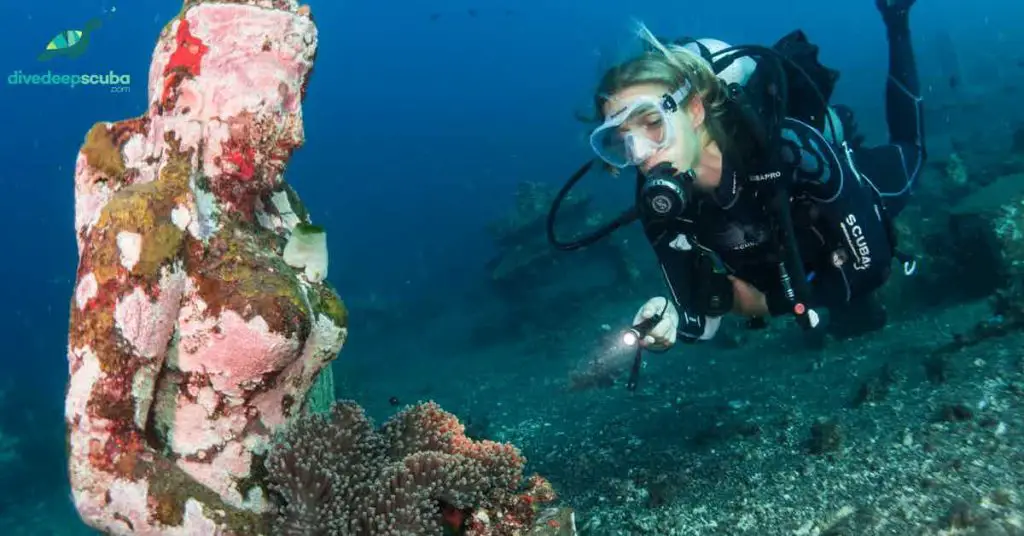The Complete Guide to Scuba Knives, Flashlights, and Pony Bottles
There are many things a diver needs when going underwater! Some for safety, some for communication and some to make the dive more enjoyable! Today we are having a look at three scuba accessories that are very important parts of Scuba diving gear.
There are a few things to consider when choosing a scuba knife, flashlight or pony bottle, such as:
- What is your budget?
- Where do you want the knife located on your scuba gear?
- What will you use the flashlight for?
- Do you want a wide or narrow light beam?
- Are you a solo diver?
If you are a Scuba diver with your own gear, as you advance, you will notice your gear will too. These three pieces of equipment can come in handy in many different situations.
This guide is to help introduce you to what they are, why you might need them and things to consider when buying them. So, let’s jump in!
What is a Scuba Knife?
A scuba knife a small/medium-sized sharp knife that scuba divers take underwater with them. They are most commonly located in a case attached to a BCD pocket or LPI. Sometimes, divers might have this case strapped around their lower leg.
Often, scuba knives are blunt-ended, to reduce the chances of the diver injuring himself.
Why you Might Need a Scuba Knife?
For Scuba divers, a knife is an essential item to take underwater. They can help relieve you, your buddy or even marine life from entanglement in plants, rope or discarded fishing nets/lines etc. Having a dive knife could be the difference between life or death underwater.
They are most commonly two-sided, with one smooth sharp blade and one jagged blade, each for different purposes. The smooth side is used to cut fishing lines or string, and the jagged side is used to saw rope or kelp. This can be very crucial underwater, to relieve a diver from entanglement.
Not only are they an important piece of equipment for safety, but they can help collect sections of fishing nets that may have got caught on corals or objects underwater. A knife can help cut and detangle rubbish, which can be collected and disposed of on land.
Scuba knives could also be used to tap on the back of your tank in order to get another divers attention! Although try not to do this often as it is not very popular in the diving community!
Things to consider when buying a scuba diving knife:
- Budget
- Placement

How Much Does a Dive Knife Cost?
Scuba knives can range between $50-$200. In comparison to other pieces of equipment, this is not too pricey.
However, when deciding which scuba knife to buy, your budget will most likely determine which one you will purchase. Most scuba knives are pretty similar, they just vary in quality and price. The more you spend on a scuba knife, the more likely it will last longer before rusting.
Blunt-End Dive Knives:
- Scubapro White Tip Dive Knife
- Atomic Ti6 Titanium Dive Knife with Blunt Point
- Tusa Imprex X-Pert II Scuba Diving Blunt Point Knife
Sharp-End Dive Knives:
Where Do I Wear my Dive Knife?
It is most common to see a scuba knife attached to a scuba divers BCD. The knife case is attached to the outside of the BCD near the pockets. Some divers have it attached to their LPI hose, but the position is completely dependent on what you find most comfortable.
You might even see a scuba diver looking cool with a knife attached to their leg! (This is where I wear mine, it’s easy to grab it in an emergency but is out of the way enough to not get in the way).
How Long Should a Scuba Knife Last?
Unfortunately, scuba knives typically do not last very long. If you are diving very often, you might need to replace it after a year. They are most commonly made out of steel or titanium, therefore prone to rusting. However, this is inevitable when taking metal in and out of the water!
To increase its lifetime, you will have to take care of it well. After a dive, make sure you rinse your knife thoroughly with fresh water. Dry it, then apply a thin layer of silicone to prevent corrosion. Store it in a cool dry place.
Make sure you replace your scuba knife once it begins to rust. If it is too rusty, it won’t be efficient underwater and may not cut what you need it to. This could be very dangerous in an entanglement.
Flashlights
What is a Dive Flash Light?
A flashlight is a powerful underwater torch, which provides light when diving. There are many different types, all used for different scenarios.
Different flashlights have different amounts of lumens, which is their brightness. There are also different widths of luminosity, such as narrow and wide.
There are also many different types of flashlights! These include handheld torches, wrist strap torches, strobe lights, headlights, tank lights, and strobe and video lights for underwater cameras!
As you can see there are many different types of flashlights! It is up to you to decide if you would prefer to have a handheld, wrist strap or cable held flashlight!
Why Might You Need a Dive Flashlight?
Flashlights are used in all types of situations, such as daytime diving, night dives, technical diving and even photography!
Flashlights are great for daytime diving, as even at 30 meters things lose their vibrant colours. A light source does not have to be that bright but can bring back some beautiful colours.
It is great to have a small compact flashlight with you on every dive for those times you would like a little extra light! For example, when you are peeping under a shark cave and want to illuminate under the rock! You may also want to have a snoop in cracks and crevices to see some eels or an octopus.
Unlike during the day, flashlights are a necessity when night diving. Scuba divers are required to have a primary and a backup as a safety measure. These flashlights are used to see marine life, for communication and safety.
Divers should have high lumens and a wide beam, to maximise visibility during night dives. When it comes to flashlights, the brighter the better!
Flashlights are also very important during cave diving! Once entering a cave, natural light is lost and it’s the same light conditions as a night dive. Therefore, just like a night dive, bright lights are required. Yes, a backup too.
Things to consider when buying a flashlight:
- Budget
- Batteries
- Size and Diameter (narrow/wide)
- Strength
- Depth

How Much Does a Dive Flashlight Cost?
Budget is again, a strong factor that will influence your choice of flashlights. They can range from $50-£200 and more. The more expensive flashlights are those with higher lumens, rechargeable batteries and longer battery life.
They are of higher quality and less likely to flood, however, unfortunately, anything could happen to cause any flashlight to flood. This is why you should always have a spare on night dives and cave dives!
I recommend the Nova 850R. This torch is heavy-duty and also comes in a wide-angle version.
If you want a less expensive, pocket torch, the XS Scuba LT360 is the way to go. It may be small but it has an impressive 1000 lumen output.
Batteries
It is really important to consider the batteries when buying a flashlight. It can become quite expensive if you have to keep buying new, replaceable batteries.
A flashlight with rechargeable batteries is great, not only for the environment but for convenience. You can recharge the battery any time you need to, and when travelling you do not need to carry lots of spare batteries.
When diving in remote locations, finding a place to buy new batteries is not always possible! Most flashlights these days have the option or automatically come with a rechargeable battery and a charger.
Size and Diameter
Sizes can vary with flashlights, some being longer, some shorter and thicker.
The Diameter of a flashlight’s beam is also something to consider. Wide beams provide more visibility on night dives, placing more in view. Whereas narrow beams concentrate the light into a smaller circumference.
This can be useful during daytime diving, where there is already light, but you would like to illuminate a specific area. Narrow beams can focus on macro or sharks in their caves!
Strength and Depth
Most dive flashlights are able to reach 100-150m, but it is crucial to check that your dive flashlight can reach the depths you require before purchasing. The last thing you want is to flood your flashlight during a night dive! However, you should always have a backup in case something like this happens!
Different activities will require a different amount of lumens! During a night dive, a bright flashlight is best. Most flashlights are around 1500-3000 lumens.
As you can guess, not only will the flashlight be brighter as the lumens increase, but it will be more expensive!
How Long Should a Dive Flashlight Last?
If you take care of your flashlight, it should last you 3-6 years (depending on how often you dive). To take care of it, you should rinse it in freshwater after every dive.
Let it dry, then leave it open in a cool dry place for storage. Keeping it open prevents the battery from corroding. Every so often, apply silicone to the O-ring of the flashlight, to keep it flexible and prevent it from bursting underwater and flooding your flashlight!
Good quality flashlights with rechargeable batteries should last you a couple of years if you are diving frequently, if you take care of it, and are lucky to not have any incidents with it flooding underwater.
If you do not dive very often, it could last a very long time!
Pony Bottles
What is a Pony Bottle?
A pony bottle is a small cylinder with an independent regulator, used as an emergency supply of backup air. It should be enough to take you to the surface. It should never be integrated into your dive plan.
Why you might need a Pony Bottle?
Pony bottles provide an emergency supply of air to get back to the surface in case something happens to your main supply. Solo divers require this small cylinder for backup air because they do not have a buddy to share air with and emergency ascend.
These small cylinders are to supply a redundancy of air, and never to be factored into your dive plan. Pony bottles should also never be used to increase your bottom time, only as emergency backup supplies.
Even when diving with buddies who can supply air in an emergency, a pony bottle can be commendable, as you should be prepared for anything.
Things to consider when buying pony bottles:
- What will you use it for?
- Budget
- Capacity
What are Pont Bottles Used For?
If you are not solo diving, it is not crucial to have a pony bottle as you will have your buddy to rely on to share air in an out of air situation. However, if you want the extra level of security, it is good to always have this backup redundancy air.
How Much do Pont Bottles Cost?
Budgets do not have as much effect on buying pony bottles as it does knives and flashlights. Most pony bottles are around $150 for a 3L cylinder, not including the independent regulator that is required.
Capacity
In Europe, a typical pony bottle is 2-3L. In comparison to usual scuba diving tanks, this is a very small cylinder. This is because it is only used to provide a few breaths to reach the surface in an emergency out of air situation.
How long should a pony bottle last?
Pony bottles should be treated the same as any diving cylinder. They should be visually inspected annually and hydrostatically tested every 2-7 years based on the countries policies.
Therefore a pony bottle can last over 5 years, as long as it passes all the tests. It should also be taken care of, kept out of sunlight and always filled correctly.
Once a cylinder starts to fail the tests, it needs to be replaced. With tanks that are being used very frequently, this might start to happen after 3-7 years. However, if the tank is not getting used very often, as long as it stays dry and clean, it will last a lot longer.
Don’t Forget Your Dive Insurance!
Before you go out on any dive trip or holiday, it is essential to make sure you have insurance that covers you if something goes wrong. Check out our dive insurance article for more information.
Or go straight to these dive insurance company websites:
If you liked this article, please follow us on Instagram, Twitter and like our Facebook page
Conclusion
I hope this has offered you some guidance in understanding why these accessories are important and helps you decide what you need for your underwater adventures!
Please share this article using the social media buttons!
